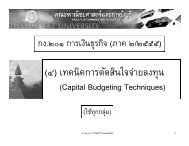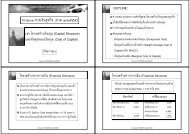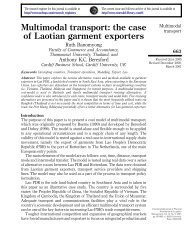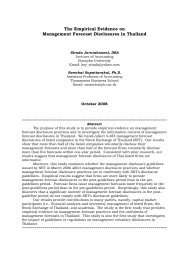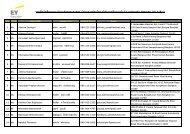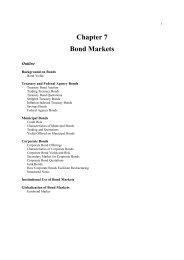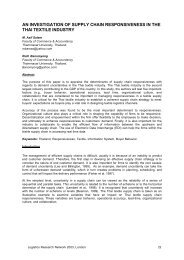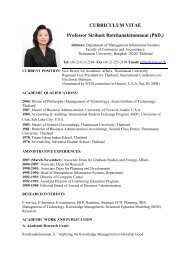The Role of Communication Strategies in Change Management ...
The Role of Communication Strategies in Change Management ...
The Role of Communication Strategies in Change Management ...
Create successful ePaper yourself
Turn your PDF publications into a flip-book with our unique Google optimized e-Paper software.
2.2 <strong>Communication</strong> Strategy <strong>The</strong>ories<br />
Somboon Kulvisaechana<br />
2.2.1 <strong>The</strong> Fundamental <strong>of</strong> <strong>Communication</strong>s<br />
Undoubtedly, communication proves to be <strong>of</strong> the most significant tools <strong>in</strong> social life and<br />
bus<strong>in</strong>ess management. It also plays a pivotal role <strong>in</strong> collaborat<strong>in</strong>g all human activities that<br />
l<strong>in</strong>k people together and create relationships (Duncan and Moriarty, 1998). Moreover, <strong>in</strong> the<br />
organizational level, Barker and Camarata (1998) assert that communication is embedded <strong>in</strong><br />
every aspect <strong>of</strong> becom<strong>in</strong>g an effective organization and <strong>of</strong> cont<strong>in</strong>u<strong>in</strong>g to be a learn<strong>in</strong>g<br />
organization. As such, organizational communication is essentially viewed as the collective<br />
<strong>in</strong>teractive process <strong>of</strong> generat<strong>in</strong>g and <strong>in</strong>terpret<strong>in</strong>g messages between people with<strong>in</strong> the<br />
organization through either directional (one-way) or bidirectional (two-way) manner <strong>of</strong><br />
communication (Stohl, 1995). For <strong>in</strong>stance, the nature <strong>of</strong> hierarchical relationships with<br />
communication patterns is exam<strong>in</strong>ed <strong>in</strong> the research <strong>of</strong> Stohl (1995). It is found that a high<br />
bureaucratic organization tends to shape its communication practices <strong>in</strong> a vertical formal<br />
way, such as a top-down cha<strong>in</strong> <strong>of</strong> command through written forms <strong>of</strong> communication, while<br />
personal <strong>in</strong>teractions may not be well exposed.<br />
Orig<strong>in</strong>ally, Kreitner and K<strong>in</strong>icki (1995: p. 368), quoted from Bowditch and Buono (1994),<br />
def<strong>in</strong>e communication as “the exchange <strong>of</strong> <strong>in</strong>formation between a sender and a receiver, and<br />
the <strong>in</strong>ference (perception) <strong>of</strong> mean<strong>in</strong>g between the <strong>in</strong>dividuals <strong>in</strong>volved” so as to reach a<br />
common understand<strong>in</strong>g (George and Jones, 1998).<br />
Recently, a description <strong>of</strong> communication theories has expanded to cover more <strong>of</strong><br />
psychological and cognitive aspects. In the literature <strong>of</strong> Weiss (2001) and Kreitner and<br />
K<strong>in</strong>icki (1995), a perceptual model <strong>of</strong> communication is basically elaborated from a<br />
traditional communication process model (Schermerhorn, 1998; Baguley, 1994). In the<br />
perceptual model, the cognitive <strong>in</strong>terpretation <strong>of</strong> messages is focused by which the<br />
miscommunication becomes better understood (Kreitner and K<strong>in</strong>icki, 1995).<br />
Accord<strong>in</strong>g to the work <strong>of</strong> Kreitner and K<strong>in</strong>icki (1995) <strong>in</strong> Figure 6, a perceptual model <strong>of</strong><br />
communication beg<strong>in</strong>s with a sender cognitively encodes an idea or thought by us<strong>in</strong>g verbal<br />
and non-verbal cues, <strong>in</strong>clud<strong>in</strong>g attitudes. <strong>The</strong> output <strong>of</strong> encod<strong>in</strong>g is a message transmitted on<br />
medium selected by the sender. <strong>The</strong>n the receiver cognitively decodes that idea or thought<br />
based on his/her understand<strong>in</strong>g and perception toward the message. A message for feedback<br />
16




